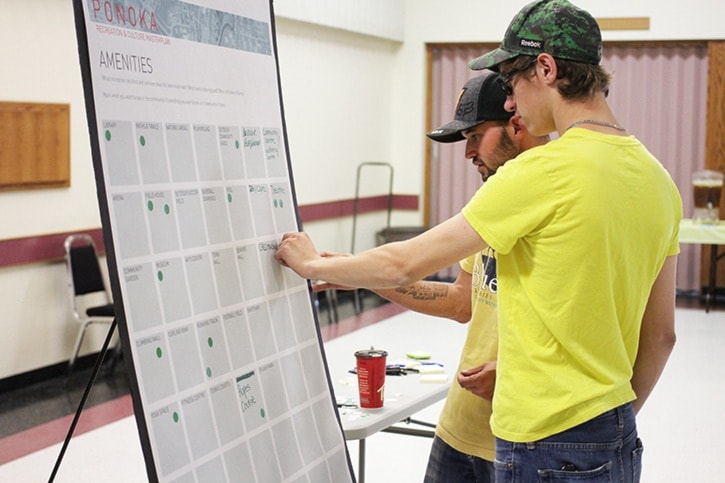A community design workshop hosted by the Town of Ponoka shows there is strong potential for a multi-purpose recreation facility but collaboration is key to getting the job done.
Gary Debney of McElhanney Consulting Services spoke Monday, June 15 at the workshop held at the Kinsmen community centre on what is needed to go from having a plan to a fully operational recreation building.
He said community buy-in is vital to seeing the project to completion. “It’s all about the community coming together, putting this together to make a vision happen,” explained Debney.
McElhanney Consulting Services was hired by the Town of Ponoka to put together a concrete plan for future recreation in the municipality. Debney said planners set a long-term 30-year plan that will provide guidelines as to how that will look.
Dubbed Vision 2045 for a completed Community Activity and Wellbeing Centre, Debney said the focus of his team was to look at immediate needs and wants for residents.
Needs and wants for the Town of Ponoka
Among the immediate needs are the replacement of the North Bridge, the RCMP detachment and Town Hall.
Parks and trails were considered as well as immediate wants for recreation and culture. Facilities such as an indoor track and a fieldhouse are areas residents have indicated the biggest desire for.
With those in mind, McElhanney Consulting also looked at existing facilities, the life left in them and needs of the community. Debney suggested that while the town does already have an aquaplex, its estimated life is relatively short compared to the newly renovated Ponoka Culture and Recreation Complex.
“You have the right range of facilities. You may not have the quality of facilities you’d like to see,” explained Debney.
Comparing Ponoka to others
He compared Ponoka’s facilities compared to municipalities of similar population size. Bonnyville, Devon and Rocky Mountain House all have a similar population and there are few differences between the four, except that Bonnyville does have a field house. Amenities such as skate parks, splash parks, soccer pitches and outdoor rinks can be found in all four communities.
Debney said Ponoka’s strengths lie in a wide range of facilities and programs, many of which are run by user groups. Its weaknesses however, are in aging infrastructure and a lack of focus on arts and culture.
Despite those challenges, there are positive opportunities as well: downtown revitalization, the Battle River Valley and a green network. Another important area of opportunity is in potential partnerships and strategic alliances with municipalities, community groups and corporations to develop a facility.
“All the potential partnerships including the corporate sector are really important,” said Debney.
The biggest hindrance to a multiuse facility? Inaction. “But the important thing is it’s gotta be coordinated. It’s gotta bring a vision.”
Helping see such a building maintained and developed will also need an influx of younger families. Debney says part of the 30-year plan has to look at what the future population of Ponoka will look like and what residents want this future facility to look like.
One piece of information Debney would like to see more detail from residents is a concrete idea of what this new building should look like.
Potential building ideas
Debney provided four ideas of what the multi-use facility could look like.
- A recreation multiplex similar to the one in Blackfalds;
- A campus-style complex that allows for the purchase of land and future expansion. Debney said many shopping centre developers are using this second option as it allows for expansion without large capital investment.
- Scattered facilities throughout the town;
- A central downtown area designated for recreation development. Debney says this last option can be expensive and difficult to purchase the land.
“The question we have for you is which do you think is best?” said Debney.
He added that the only way to ensure the project works is having the community supporting council’s vision for the future; that, and strong collaboration between the different groups. Debney said making the dream a reality is not an easy job but it is worth the effort for the results.
There was some concern from one resident who said paying for the general operations of a facility will be high. Debney replied there are some communities that specifically hired a director whose job it is to ensure the programming meets the needs of the community and makes money.
Peter Hall, chairperson of the recreation committee, said Bonnyville’s recreation building went from a $700,000 total subsidy between the town and county to a $50,000 total subsidy after hiring a programming team.
“They (staff) program the building. It’s a full time job but it can be done,” said Hall.
Debney added that there are some sports groups in other communities that plan for future development of facilities by ensuring a fee is paid into a capital development program.
“But you’ve got to get the facility mix right, right from the get go,” said Debney.
With further input from residents, Debney said planners can put together a clear vision of what this new building plan will look like. A concrete plan will also make it easier to apply for recreation grants, he added.
“How can we focus that and put money to the best use?” asked Debney.
He said McElhanney Consulting Services intends to gain specific feedback from residents on what they would like to see in a new facility in the fall. This will help the company compile a clear vision for review.
Among the more than 30 community members who attended were town councillors, members of the Ponoka Recreation Advisory Committee and the Economic Development Board as well as Ponoka County councillors Mark Matejka and Bryce Liddle.
Crunching some numbers
If 3,000 households from the Town of Ponoka and 3,000 households from Ponoka County came together to help pay for a $20 million building, the shared cost would be $3,333 each. That amount does not take into account potential government grants and corporate donations.
